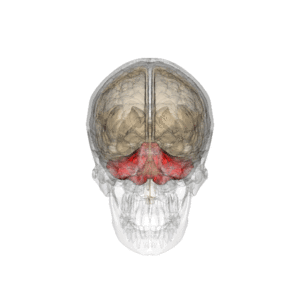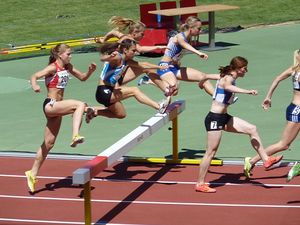Coordination Exercises: Difference between revisions
(athletes added) |
(media) |
||
| Line 5: | Line 5: | ||
</div> | </div> | ||
== '''Introduction''' == | == '''Introduction'''[[File:Juggle.gif|frameless]] == | ||
The definition of coordination exercises is the ability to execute smooth, accurate, controlled motor responses (optimal interaction of muscle function). | The definition of coordination exercises is the ability to execute smooth, accurate, controlled motor responses (optimal interaction of muscle function). | ||
* Coordination is the ability to select the right muscle at the right time with proper intensity to achieve proper action. | * Coordination is the ability to select the right muscle at the right time with proper intensity to achieve proper action. | ||
| Line 60: | Line 60: | ||
* Walking along a straight line. Foot close to foot:In case of cerebellar lesion, there is deviation of gait | * Walking along a straight line. Foot close to foot:In case of cerebellar lesion, there is deviation of gait | ||
* Rom-berg test: Ask the patient to stand with heels together. Swaying or loss of balance occurs while his eyes are open or closed. | * Rom-berg test: Ask the patient to stand with heels together. Swaying or loss of balance occurs while his eyes are open or closed. | ||
[[File:Coordination.jpeg|right|frameless]] | |||
== Coordination Tests for Athletes / Everyday sports person == | == Coordination Tests for Athletes / Everyday sports person == | ||
Revision as of 08:12, 12 June 2019
Original Editor - Rewan Aloush
Top Contributors - Rewan Aloush, Lucinda hampton, Joseph Olamide, Kim Jackson, Rachael Lowe, Joao Costa, Leana Louw, Amanda Ager and Lauren Lopez
Introduction [edit | edit source]
[edit | edit source]
The definition of coordination exercises is the ability to execute smooth, accurate, controlled motor responses (optimal interaction of muscle function).
- Coordination is the ability to select the right muscle at the right time with proper intensity to achieve proper action.
- Coordinated movement is characterized by appropriate speed, distance, direction, timing and muscular tension.
- It is the process that results in activation of motor units of multiple muscles with simultaneous inhibition of all other muscles in order to carry out a desired activity.[1]
The cerebellum is the primary centre in the brain for coordination for movement and the ability to execute smooth accurate motor response depends on:
- Deep sensations.
- Vision.
- Vestibular system and cerebellum.
- Motor system.
- Flexibility and ROM.
Components of Coordinated Movement[edit | edit source]
Coordinated movement is dependent on:
- Volition: is the ability to initiate, maintain or stop an activity or motion.
- Perception:in tact proprioception and subcortical centres to integrate motor impulses and the sensory feedback. When proprioception is affected it is compensated with visual feedback.
- Engramformation: is the neurological muscular activity developed in the extrapyramidal system. Research proved that high repetitions of precise performance must be performed in order to develop an engram.
Types of Coordination[edit | edit source]
Motor coordination to complete a task a collaboration of three skills:
- Fine Motor Skills
- Require coordinated movement of small muscles (hands, face).
- Examples: include writing, drawing, buttoning a shirt, blowing bubbles
- Gross Motor Skills
- Require coordinated movement of large muscles or groups of muscles (trunk, extremities).
- Examples: include walking, running, lifting activities.
- Hand-eye Skills
- The ability of the visual system to coordinate visual information. Received and then control or direct the hands in the accomplishment of a task.
- Examples : include catching a ball,sewing,computer mouse use.[1]
Causes of Coordination Impairments[edit | edit source]
Injury, disease, lesion of cerebellum and basal ganglia (ataxia, parkinsonism)
- Alcohol/drug intoxication
- Poisoning
- Infectious diseases
Examples of Coordination Tests in the upper limb[edit | edit source]
In the following tests, you will be looking for signs of Intention tremors and Decomposition of movements or Dysmetria: in the form of hypermetria or hypometria
- Finger-to-nose test - The shoulder is abducted to 90o with the elbow extended, the patient is asked to bring tip of the index finger to the tip of nose.Finger to therapist finger: the patient and the therapist site opposite to each other, the therapist index finger is held in front of the patient, the patient is asked to touch the tip of the index finger to the therapist index finger.
- Finger-to-finger test - Both shoulders are abducted to bring both the elbow extended, the patient is asked to bring both the hand toward the midline and approximate the index finger from opposing hand
- Finger-to-doctor's finger test - the patient alternately touch the tip of the nose and the tip of the therapist's finger with the index finger.
- Adiadokokinesia or dysdiadokokinesia - The patient asked to do rapidly alternating movement e.g. forearm supination and pronation, hand tapping.
- Rebound phenomena - The patient with his elbow fixed, flex it against resistance. When the resistance is suddenly released the patient's forearm flies upward and may hit his face or shoulder.
- Buttoning and unbuttoning test.
Examples of Coordination Tests in the lower limb[edit | edit source]
- Walking along a straight line. Foot close to foot:In case of cerebellar lesion, there is deviation of gait
- Rom-berg test: Ask the patient to stand with heels together. Swaying or loss of balance occurs while his eyes are open or closed.
Coordination Tests for Athletes / Everyday sports person[edit | edit source]
Stick Flip Coordination Test; Wall-Toss Test; Block Transfer; Soda Pop Test; Plate TappingLight Board; Test Heel-to-knee test
General Principles of Coordination Exercises Involve[edit | edit source]
- Constant repetition of a few motor activities
- Use of sensory cues (tactile, visual, proprioceptive) to enhance motor performance
- Increase of speed of the activity over time
- Activities are broken down into components that are simple enough to be performed correctly.
- Assistance is provided when ever necessary.
- The patient therefore should have a short rest after two or three repetitions, to avoid fatigue.
- High repetition of precise performance must be performed for the engram to form.
- When ever a new movement is trained, various inputs are given, like instruction(auditory), sensory stimulation(touch) ,or positions in which the patient can view the movement (visual stimulation) to enhance motor performance.[1]
Therapeutic Exercises Used to Improve Coordination[edit | edit source]
There are many interventions that can be utilised to improve coordination, such as:
- Tai Chi
- Pilates
- Yoga
- Otago Exercise Program
- Neuromuscular coordination exercises. Check out the advanced examples of these below.
- Proprioceptive Neuromuscular Facilitation. The below video shows PNF is use
- Neurophysiological Basis of Developmental Techniques
- Sensory Integrative Therapy
- Frenkel’s Exercises [4]
Evidence[edit | edit source]
There is a lot of good evidence for the inclusion of coordination exercises for a whole raft of conditions.
A Cochrane review (2015) into the effectiveness of pilates in low back pain found positive results. Low to moderate quality evidence showed Pilates as a more effective intervention than minimal intervention in the short and intermediate term reducing pain intensity and disability, with most of the effect sizes being considered medium. [5]
A 2015 study investigating the effect of coordination movement using the Proprioceptive Neuromuscular Facilitation pattern underwater on the balance and gait of stroke patients had positive news. The study found that coordination movement using the PNF pattern can be an appropriate therapy method for stroke patients who have problems with gait because of declined weight support and balancing ability. Improvements were found in both functional reach and BBT.[6]
A 2011 study "Effectiveness of coordination exercise in improving cognitive function in older adults: a prospective study" found that low-intensity level mind-body exercise could be beneficial to the cognitive functioning of older adults.[7]
A 2015 study into the effectiveness of a sensory integration program in motor skills in children with autism concluded that it was an effective treatment helping autistic children to become more independent and participate in everyday activities.[8]
A study into the effects of Tai Chi Chuan (TCC) Coordination exercise on elderly people concluded that " elderly people who regularly practice TCC show better postural stability in the more challenging conditions than those who do not (eg, conditions with simultaneous disturbance of vision and proprioception). TCC as a coordination exercise may reduce the risk of falling by maintaining the ability of posture control. TCC is strongly recommended as a regimen of coordination exercise to prevent the elderly from falling."[9]
A study involving stroke patients and the effectiveness of Frenkels exercises found significant gains in relation to coordination, balance and functional activities with the inclusion of Frenkel exercises in physical therapy approach. [10]
References:[edit | edit source]
- ↑ 1.0 1.1 1.2 Slide player Coordination exercises Available from: http://slideplayer.com/slide/4638093/ (last accessed 11.6.2019)
- ↑ UEFA Neuromuscular coordination’s exercises Available from: https://www.youtube.com/watch?v=ktWVZ1gkW_c (last accessed 11.6.2019)
- ↑ physio classroom RHYTHMIC INITIATION TECHNIQUE : PNF THERAPY PART-4 Available from: https://www.youtube.com/watch?v=03YaX9qXtdw (last accessed 11.6.2019)
- ↑ Frenkel exercises in rehab Wohl Physiotherapy Available from: https://www.youtube.com/watch?v=R83KEKtGcTQ (last accessed 11.6.2019)
- ↑ Yamato TP, Maher CG, Saragiotto BT, Hancock MJ, Ostelo RW, Cabral CM, Costa LC, Costa LO. Pilates for low back pain. Cochrane Database of Systematic Reviews. 2015(7). Available from: https://www.cochranelibrary.com/cdsr/doi/10.1002/14651858.CD010265.pub2/media/CDSR/CD010265/CD010265.pdf
- ↑ Kim K, Lee DK, Jung SI. Effect of coordination movement using the PNF pattern underwater on the balance and gait of stroke patients. Journal of physical therapy science. 2015;27(12):3699-701. Available from: https://www.ncbi.nlm.nih.gov/pmc/articles/PMC4713774/ (last accessed 12.6.2019)
- ↑ Kwok TC, Lam KC, Wong PS, Chau WW, Yuen KS, Ting KT, Chung EW, Li JC, Ho FK. Effectiveness of coordination exercise in improving cognitive function in older adults: a prospective study. Clinical interventions in aging. 2011;6:261. Available from: https://www.ncbi.nlm.nih.gov/pmc/articles/PMC3212417/ (last accessed 12.6.2019)
- ↑ Karim AE, Mohammed AH. Effectiveness of sensory integration program in motor skills in children with autism. Egyptian Journal of Medical Human Genetics. 2015;16(4):375-80. Available from: https://www.sciencedirect.com/science/article/pii/S1110863015000038 (last accessed 12.6.2019)
- ↑ Wong AM, Lin YC, Chou SW, Tang FT, Wong PY. Coordination exercise and postural stability in elderly people: effect of Tai Chi Chuan. Archives of physical medicine and rehabilitation. 2001 May 1;82(5):608-12. Available from: https://www.archives-pmr.org/article/S0003-9993(01)13337-X/fulltext#s0060 (last accessed 12.6.2019)
- ↑ Pin, Alessandro & Nascimento, Rosiane & Gonçalves da Costa, Jonathas & Bruno Ferro, Sidney & Santos, Marcelo. (2011). Frenkel Exercises in rehabilitation after AVE hemorrhagic stroke with involvement cerebellar: a case report. Fisioterapia Ser. 6. 37 - 40. Available from: https://www.researchgate.net/publication/259969581_Frenkel_Exercises_in_rehabilitation_after_AVE_hemorrhagic_stroke_with_involvement_cerebellar_a_case_report (last accessed 12.6.2019)








